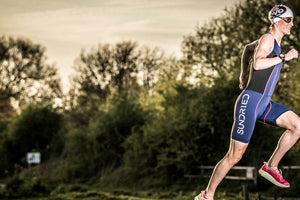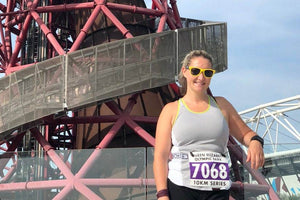Top 10 Ways to Dive into Triathlon: From Beginner to Finisher
Triathlon. The word itself conjures images of superhuman athletes conquering gruelling distances. But the reality is far less intimidating. Triathlon is a sport for everyone, regardless of age, shape, size, or ability. It's about your personal journey, pushing your own limits, and experiencing the incredible sense of accomplishment that comes with crossing the finish line. This guide, drawing from expert advice, will equip you with the knowledge and confidence to take the plunge.
Want a quick and easy way to digest the world of triathlon?
Click play below to hear our triathlon guide podcast:
1. Mindset: Your Greatest Asset
Forget comparing yourself to others. Triathlon is a personal challenge. Embrace the journey, celebrate small victories, and remember:
- Triathlon is for every body: This sport welcomes everyone. Don't let perceived limitations hold you back.
- Focus on your journey: Your motivation is key. It has to come from within.
- Positive self-talk is your superpower: Reframe negative thoughts and build confidence through affirmations.
- Imperfection is part of the process: Mistakes happen. Learn from them and move forward.
2. Training Smart: Building a Strong Foundation
Effective training is the cornerstone of triathlon success. Here's how to structure your preparation:
- Brick workouts are essential: These bike-to-run sessions prepare your body for the unique challenge of running after cycling.
- Swim with purpose: Don't just churn out laps. Focus on technique, drills, and varied sessions incorporating speed, threshold, and endurance work. Consider lessons or instructional videos.
- Gradual progression is key: Start with shorter distances and gradually increase intensity and duration.
- Volume matters (especially for running): "Run more...More days, more miles" is a simple but effective mantra for running improvement.
- Fuel your body: Nutrition is crucial, especially for longer distances like half-Ironman and Ironman. Develop a race-day nutrition plan during training.
- Strength training: A personal choice: While it can offer benefits, it's not the most efficient way to improve swim, bike, or run times if race performance is your primary goal.
3. Conquering the Swim: Open Water Confidence
The swim, particularly in open water, can be daunting. Here's how to tackle it:
- Open water anxiety is normal: Many triathletes experience this. You're not alone.
- Overcome panic with breath control: Focus on your breathing, the next stroke, and practice sighting. It's okay to switch strokes if needed.
- Address the mammalian diving reflex: Cold water can trigger this reflex. Practice bobbing and blowing bubbles.
- Safety first: Invest in a tow float: It provides buoyancy and a sense of security.
- Practice open water sighting: Don't make the swim harder than it needs to be.
- Drafting is your friend (in the swim): Unlike cycling, drafting is legal and can save energy.
4. Transition Mastery: Smooth and Efficient
Transitions (T1 and T2) are where races can be won or lost. Practice makes perfect:
- Simulate transitions in training: Include brick workouts to get comfortable with the bike-to-run transition.
- Strategic planning is key: Organise your gear and have a clear plan for each transition.
5. Cycling Savvy: Pedal to Success
From bike fit to basic skills, cycling proficiency is essential:
- Get a professional bike fit: This is crucial for comfort and efficiency, regardless of your bike type.
- Road bike vs. Tri-bike: A road bike is a great starting point and versatile for general riding.
- Master basic skills: Learn how to change a tyre and improve your road cycling skills.
- Comfort is king (or queen): A good saddle is essential, especially for women. Consider a women's-specific saddle if needed.
6. Running Strong: Stride with Confidence
Running efficiently is key to a strong triathlon finish:
- Brick sessions are vital: Acclimatise your legs to running after cycling.
- Cadence matters: Focus on your stride cadence, especially for endurance runs.
- Respect the impact: Running is high-impact. Progress gradually, especially if you're coming from a cycling background.
7. Gear Up: Essential Equipment
Having the right gear can enhance your performance and comfort:
- Tri-suit: Your all-in-one outfit: Designed for all three disciplines.
- Wetsuit: Warmth and buoyancy: Essential for open water swims, especially in colder climates. A good wetsuit can improve your body position in the water.
- Running shoes: Get fitted: Properly fitted shoes are crucial for injury prevention.
- GPS watch/heart rate monitor: Track your progress: Useful tools for monitoring training and race performance.
- Rent before you buy: Consider renting a wetsuit or bike before investing.
8. Community and Support: Strength in Numbers
Connecting with other triathletes can provide invaluable support and guidance:
- Join a local triathlon club: A great way to meet training partners, get advice, and build camaraderie.
- Online forums: A wealth of information: Platforms like Reddit's r/triathlon and BeginnerTriathlete forums offer a space to ask questions and share experiences.
9. Mental Fortitude: The Power Within
Triathlon is as much a mental challenge as it is physical:
- Mental preparation is crucial: Develop strategies to manage stress and stay focused.
- Be adaptable: Race plans can change. Be prepared to adjust based on conditions and how you feel.
- Enjoy the journey: Remember why you started. Celebrate your achievements and embrace the experience.
10. Triathlon Terminology: Decoding the Lingo
Familiarise yourself with common triathlon terms like "brick workout," "transition," "cadence," "drafting," "race pace," and "VO2 max" to better understand training plans and race strategies.
This guide provides a solid foundation for your triathlon journey. Remember, it's about pushing your own boundaries, celebrating your progress, and enjoying the incredible experience of becoming a triathlete. So, take the plunge, embrace the challenge, and prepare to cross that finish line!







